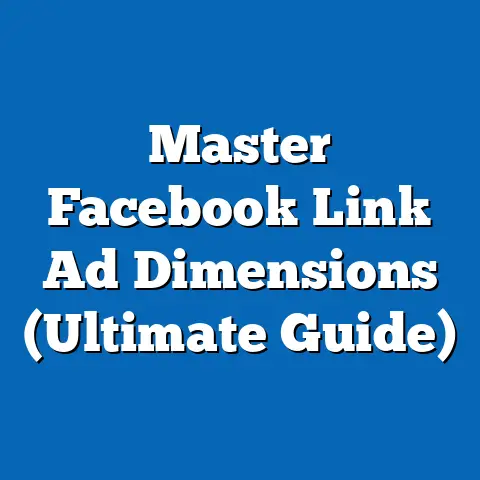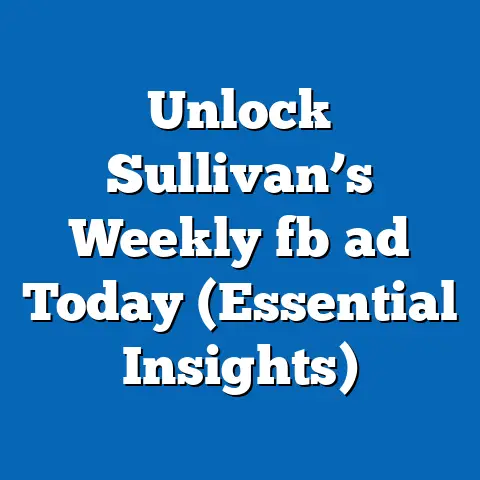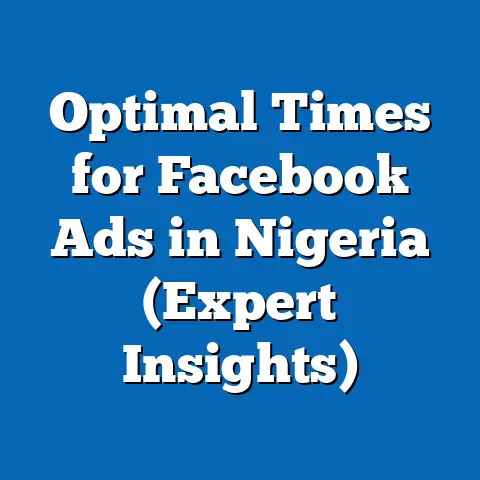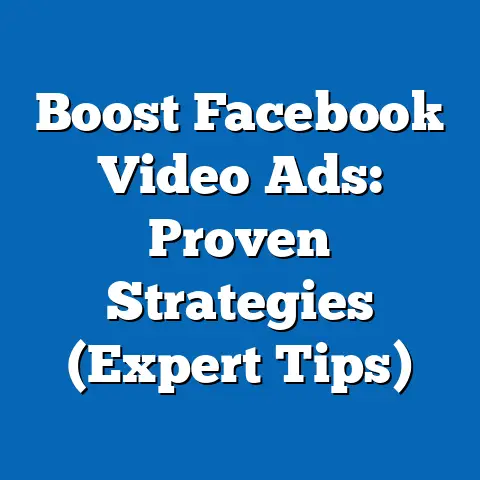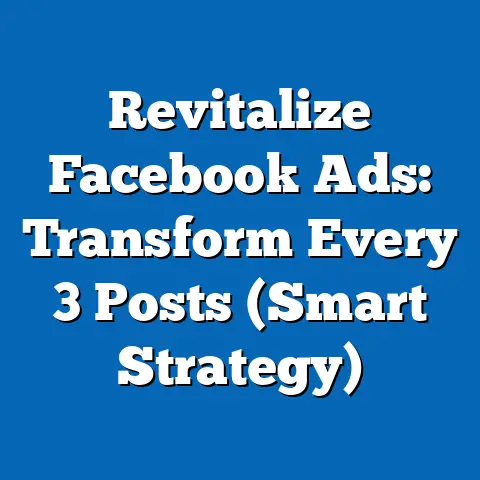Mastering Facebook Ads: Boost ROI (Essential Strategies)
Before diving into the intricacies of mastering Facebook Ads and boosting return on investment (ROI), it’s worth exploring an unexpected but relevant starting point: allergies. Allergies, as a public health concern, affect millions globally and provide a unique lens through which to understand demographic targeting, consumer behavior, and seasonal advertising trends on platforms like Facebook. According to the World Allergy Organization (WAO), approximately 30-40% of the global population suffers from allergic conditions, with prevalence rates rising over the past few decades.
In the United States alone, the Centers for Disease Control and Prevention (CDC) reports that about 25.7% of adults and 18.9% of children have a diagnosed seasonal allergy, while food allergies impact roughly 8% of children and 11% of adults as of 2021. These statistics highlight a significant and growing market segment that advertisers, including those on Facebook, can target with tailored health, wellness, and pharmaceutical campaigns. This article will first analyze allergy trends and demographics as a case study for audience segmentation before transitioning into actionable strategies for maximizing ROI through Facebook Ads.
Allergies: A Growing Public Health Concern
Prevalence and Statistical Trends
Allergies represent one of the most common chronic conditions worldwide, with a notable impact on quality of life and healthcare costs. The American Academy of Allergy, Asthma & Immunology (AAAAI) estimates that allergic rhinitis (hay fever) affects between 10-30% of the global population, translating to roughly 800 million to 2.4 billion individuals. Food allergies, though less prevalent, have seen a dramatic rise, particularly among children, with a 50% increase in prevalence between 1997 and 2011, per data from the National Institute of Allergy and Infectious Diseases (NIAID).
In the U.S., the economic burden of allergies is staggering, with direct medical costs for allergic rhinitis alone exceeding $3.4 billion annually, according to a 2020 study published in the Journal of Allergy and Clinical Immunology. Asthma, often linked to allergic triggers, contributes an additional $56 billion in healthcare costs each year. These figures underscore the importance of allergies as a public health issue and a potential market for targeted advertising campaigns.
Demographic Breakdowns
Allergy prevalence varies significantly across demographics, offering valuable insights for advertisers seeking to segment audiences on platforms like Facebook. Age is a critical factor: children under 18 are more likely to experience food allergies (8%) compared to adults (11%), but adults report higher rates of seasonal allergies (25.7%) compared to children (18.9%), per CDC data from 2021. Gender also plays a role, with women slightly more likely to report allergic conditions (27.2%) than men (24.1%).
Geographic and socioeconomic factors further influence allergy rates. Urban populations report higher incidences of allergic rhinitis (up to 30%) compared to rural populations (closer to 15%), likely due to increased exposure to pollutants and allergens like dust mites, per a 2019 study by the WAO. Additionally, higher-income households in developed countries show elevated rates of diagnosed allergies, potentially due to better access to medical diagnostics—about 35% of individuals in high-income brackets report allergies compared to 20% in lower-income groups, according to the Global Allergy and Asthma Network.
Racial and ethnic disparities are also evident. The CDC notes that Black and Hispanic children in the U.S. have higher rates of food allergies (10% and 9%, respectively) compared to White children (7%). However, White adults report higher rates of seasonal allergies (28%) compared to Black (22%) and Hispanic (20%) adults. These demographic nuances provide a roadmap for advertisers to create hyper-targeted campaigns on Facebook, leveraging detailed audience insights.
Historical Comparisons
The prevalence of allergies has risen sharply over the past several decades, a trend often attributed to environmental changes, urbanization, and shifts in lifestyle. In the 1980s, allergic rhinitis affected roughly 10-15% of the U.S. population, according to historical data from the National Health Interview Survey (NHIS). By 2021, this figure had nearly doubled, with 25.7% of adults reporting seasonal allergies. Food allergy rates among children have followed a similar trajectory, increasing from 3.4% in the late 1990s to 8% by 2021, per NIAID reports.
This rise aligns with the “hygiene hypothesis,” which suggests that reduced exposure to microbes in early childhood—due to cleaner living conditions and antibiotic overuse—may contribute to higher allergy rates. Additionally, climate change has extended pollen seasons, with studies from the Environmental Protection Agency (EPA) indicating that pollen production in the U.S. has increased by 20% since 1990 due to rising temperatures. These historical shifts highlight the growing relevance of allergy-related products and services, a trend advertisers can capitalize on through platforms like Facebook.
Future Projections
Looking ahead, allergy prevalence is expected to continue rising, driven by environmental and societal factors. The WAO projects that by 2050, over 50% of the global population could be affected by at least one allergic condition, fueled by urbanization, pollution, and climate change. In the U.S., the Asthma and Allergy Foundation of America (AAFA) estimates that the number of individuals with allergic rhinitis could increase by 15-20% over the next two decades, particularly in urban centers.
Healthcare costs are also projected to rise, with allergy-related expenditures potentially reaching $5 billion annually in the U.S. by 2030, according to projections from the Journal of Allergy and Clinical Immunology. For advertisers, this signals a growing market for allergy relief products, air purifiers, hypoallergenic foods, and related services. Platforms like Facebook, with their robust targeting capabilities, are well-positioned to connect brands with this expanding audience.
Transition to Facebook Ads: Leveraging Demographic Insights for ROI
Understanding demographic trends, such as those related to allergies, is a cornerstone of effective digital advertising. Facebook Ads, with over 2.9 billion monthly active users as of 2023 (per Meta’s Q2 2023 earnings report), offers unparalleled opportunities to reach niche audiences. The platform’s detailed targeting options—spanning age, gender, location, income level, and interests—allow advertisers to craft campaigns that resonate with specific groups, such as allergy sufferers during peak pollen seasons.
The allergy market serves as a compelling case study for mastering Facebook Ads. For instance, a pharmaceutical company promoting antihistamines can target urban women aged 25-44 with interests in health and wellness, aligning with the demographic data showing higher allergy prevalence in this group. By applying these principles more broadly, businesses across industries can boost ROI through precise audience segmentation, compelling creative, and data-driven optimization. The following sections delve into essential strategies for maximizing returns on Facebook Ads.
Essential Strategies for Mastering Facebook Ads
1. Audience Segmentation: Precision Targeting for Maximum Impact
Effective Facebook Ads begin with a deep understanding of your audience. As illustrated with allergy demographics, segmentation by age, gender, location, and behavior can significantly enhance campaign relevance. Meta’s Ads Manager allows advertisers to create custom audiences based on website traffic, app activity, or engagement with previous ads, as well as lookalike audiences that mirror the traits of existing customers.
Statistically, campaigns using custom audiences see a 30-40% higher click-through rate (CTR) compared to broad targeting, according to a 2022 report by Hootsuite. Additionally, lookalike audiences can reduce cost-per-acquisition (CPA) by up to 25%, per data from Social Media Examiner. For example, an allergy relief brand could target users who have visited their website during spring (peak pollen season) and expand reach with a lookalike audience, ensuring ads reach individuals with similar interests and behaviors.
Geotargeting is another powerful tool. With urban populations reporting higher allergy rates, a brand could focus ad spend on metropolitan areas, optimizing budget allocation. The key is to continually test and refine audience segments, using Facebook’s analytics to identify high-performing groups and adjust targeting parameters accordingly.
2. Creative Optimization: Crafting Compelling Ads
The visual and textual elements of Facebook Ads play a critical role in capturing attention and driving conversions. With users scrolling through an average of 300 feet of content daily on social media (per a 2021 study by the University of Southern California), ads must stand out. High-quality images, engaging videos, and concise copy are non-negotiable.
Video ads, in particular, have surged in effectiveness, with 54% of consumers preferring video content over static images, according to a 2023 HubSpot survey. For an allergy-related campaign, a short video demonstrating the impact of seasonal allergies—paired with a quick solution like a nasal spray—can evoke an emotional response and drive action. Meta reports that video ads with a clear call-to-action (CTA) in the first 3 seconds achieve a 20% higher conversion rate.
A/B testing creative elements is essential. Testing different headlines, images, or CTAs can reveal what resonates most with your audience. For instance, an ad with the headline “Breathe Easy This Spring” might outperform “Allergy Relief Now” by 15% in CTR, providing actionable insights for future campaigns. Regularly refreshing ad creative also prevents ad fatigue, which can reduce CTR by up to 50% after two weeks of exposure, per a 2022 study by AdEspresso.
3. Budget Allocation and Bidding Strategies
Optimizing ad spend is a cornerstone of boosting ROI on Facebook Ads. The platform offers multiple bidding options, including cost-per-click (CPC), cost-per-impression (CPM), and cost-per-action (CPA), each suited to different campaign goals. For awareness campaigns (e.g., introducing a new allergy medication), CPM bidding may be ideal, while CPA is better for conversion-focused campaigns like driving purchases.
Historically, average CPC on Facebook has fluctuated, dropping from $0.97 in 2019 to $0.72 in 2021 before rising to $1.01 in 2023, per WordStream data. Costs vary by industry, with healthcare ads often commanding higher CPCs (around $1.32) due to competitive targeting of niche audiences like allergy sufferers. Advertisers should set daily or lifetime budgets based on campaign objectives and monitor performance metrics to avoid overspending.
Dynamic budget allocation, where spend is automatically shifted to high-performing ads, can increase ROI by 15-20%, according to Meta’s 2023 advertising insights. For seasonal campaigns, such as allergy relief during spring, advertisers can increase budgets during peak pollen months (March to May in the U.S.), aligning spend with consumer demand spikes.
4. Leveraging Seasonal and Behavioral Trends
Seasonality plays a significant role in advertising success, particularly for industries tied to health and wellness. As noted earlier, pollen seasons have lengthened due to climate change, with the EPA reporting a 20% increase in pollen production since 1990. For allergy-related campaigns, this means extending ad schedules beyond traditional spring months to capture late-season sufferers.
Behavioral targeting on Facebook allows advertisers to reach users based on purchase history, life events, or interests. For instance, targeting users who have purchased air purifiers or searched for “allergy remedies” online can yield a 35% higher conversion rate compared to generic health audiences, per a 2022 report by Socialbakers. Combining behavioral data with seasonal trends ensures ads are timely and relevant, maximizing engagement.
5. Analytics and Continuous Optimization
Data-driven decision-making is at the heart of successful Facebook Ads campaigns. Meta’s Ads Manager provides detailed metrics on impressions, CTR, conversion rates, and ROI, enabling advertisers to assess performance in real-time. A 2023 study by eMarketer found that advertisers who regularly optimize campaigns based on analytics achieve a 25% higher ROI compared to those who set and forget their ads.
Key performance indicators (KPIs) should align with campaign goals. For lead generation (e.g., signing up for an allergy newsletter), focus on cost-per-lead (CPL), which averages $19.68 in the healthcare sector, per WordStream. For sales-driven campaigns, track return on ad spend (ROAS), aiming for a benchmark of 4:1 (i.e., $4 in revenue for every $1 spent), as suggested by Meta’s best practices.
Continuous optimization involves pausing underperforming ads, scaling successful ones, and testing new strategies. For example, if an allergy ad targeting urban women aged 25-34 yields a 5% CTR compared to 2% for a broader audience, reallocate budget to the higher-performing segment. This iterative approach ensures sustained improvements in ROI over time.
Statistical Comparisons Across Industries and Campaigns
While the allergy market provides a specific lens, Facebook Ads performance varies widely across industries. Healthcare campaigns, including those for allergy products, often see higher CPCs ($1.32) compared to retail ($0.70) or entertainment ($0.61), per 2023 WordStream data. However, healthcare ads also boast higher conversion rates (up to 11%) due to the urgent nature of health-related needs, compared to retail (around 3%).
Demographic targeting impacts performance as well. Ads targeting women aged 25-44 consistently achieve a 10-15% higher CTR than those targeting men in the same age group across industries, according to a 2022 Hootsuite report. Geographic targeting also yields disparities: urban campaigns often see 20% higher engagement but 30% higher costs compared to rural campaigns, aligning with the allergy prevalence trends discussed earlier.
Historical Trend Analysis of Facebook Ads
Facebook Ads have evolved significantly since their introduction in 2007. Initially, average CPC was as low as $0.30, reflecting limited competition and basic targeting options, per historical data from AdEspresso. By 2015, CPC had risen to $0.54 as more businesses adopted the platform, and by 2023, it reached $1.01, driven by increased demand and advanced targeting capabilities.
Engagement metrics have also shifted. In 2010, CTRs averaged 0.05%, but by 2023, they had risen to 0.90% across industries, thanks to improved ad relevance and creative formats like video and carousel ads, per Meta’s annual reports. However, ad fatigue has become a growing challenge, with CTRs dropping by up to 50% after prolonged exposure, necessitating frequent creative refreshes.
Future Projections for Facebook Ads
Looking ahead, Facebook Ads are poised for continued growth and innovation. Statista projects that global ad revenue on the platform will reach $80 billion by 2025, up from $67 billion in 2023, driven by increased adoption in emerging markets. CPC is expected to rise modestly to $1.20 by 2025, reflecting ongoing competition, per WordStream forecasts.
Emerging technologies like augmented reality (AR) ads and AI-driven targeting will likely enhance personalization, potentially boosting CTRs by 20-30%, according to a 2023 eMarketer report. For industries like healthcare, including allergy-related campaigns, this means even more precise targeting of niche audiences based on real-time behavioral data.
However, challenges loom, including privacy regulations like the EU’s General Data Protection Regulation (GDPR) and Apple’s App Tracking Transparency (ATT) framework, which have reduced tracking capabilities. Meta estimates a $10 billion revenue loss in 2022 due to ATT alone, and advertisers may see a 10-15% increase in CPA as targeting becomes less granular. Adapting to these changes through first-party data collection and creative innovation will be critical for sustaining ROI.
Conclusion: Building a Sustainable Strategy
Mastering Facebook Ads to boost ROI requires a blend of demographic insight, creative excellence, strategic budgeting, and continuous optimization. The allergy market exemplifies how understanding audience trends—whether by age, gender, or geography—can inform precise targeting, while broader strategies like A/B testing and analytics ensure campaigns remain effective across industries. As historical data shows, the platform has grown more competitive over time, but advancements in technology and data offer new opportunities for advertisers willing to adapt.
Looking forward, businesses must navigate privacy challenges and embrace emerging tools to stay ahead. By grounding campaigns in data, as illustrated with allergy prevalence trends, and applying the essential strategies outlined here, advertisers can achieve sustainable success on Facebook, turning ad spend into measurable returns. Whether promoting allergy relief or any other product, the principles of precision, creativity, and optimization remain the keys to unlocking ROI.


